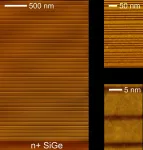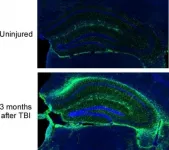Lights on for silicon photonics
The demonstration of electroluminescence at terahertz frequencies from a silicon-germanium device marks a key step towards the long-sought goal of a silicon-based laser
2021-03-08
(Press-News.org) When it comes to microelectronics, there is one chemical element like no other: silicon, the workhorse of the transistor technology that drives our information society. The countless electronic devices we use in everyday life are a testament to how today very high volumes of silicon-based components can be produced at very low cost. It seems natural, then, to use silicon also in other areas where the properties of semiconductors -- as silicon is one -- are exploited technologically, and to explore ways to integrate different functionalities. Of particular interest in this context are diode lasers, such as those employed in barcode scanners or laser pointers, which are typically based on gallium arsenide (GaAs). Unfortunately though, the physical processes that create light in GaAs do not work so well in silicon. It therefore remains an outstanding, and long-standing, goal to find an alternative route to realizing a 'laser on silicon'.
Writing today in Applied Physics Letters, an international team led by Professors Giacomo Scalari and Jérôme Faist from the Institute for Quantum Electronics present an important step towards such a device. They report electroluminescence -- electrical light generation -- from a semiconductor structure based on silicon-germanium (SiGe), a material that is compatible with standard fabrication processes used for silicon devices. Moreover, the emission they observed is in the terahertz frequency band, which sits between those of microwave electronics and infrared optics, and is of high current interest with a view to a variety of applications.
Make silicon shine
The main reason why silicon cannot be used directly for building a laser following to the GaAs template has to do with the different nature of their band gaps, which is direct in the latter but indirect in the former. In a nutshell, in GaAs electrons recombine with holes across the bandgap producing light; in silicon, they produce heat. Laser action in silicon therefore requires another path. And exploring a fresh approach is what ETH doctoral researcher David Stark and his colleagues are doing. They work towards a silicon-based quantum cascade laser (QCL). QCLs achieve light emission not by electron-hole recombination across the bandgap, but by letting electrons tunnel through repeated stacks of precisely engineered semiconductor structures, during which process photons are emitted.
The QCL paradigm has been demonstrated in a number of materials -- for the first time in 1994 by a team including Jérôme Faist, then working at Bell Laboratories in the US -- but never in silicon-based ones, despite promising predictions. Turning these predictions into reality is the focus of an interdisciplinary project funded by the European Commission, bringing together a team of leading experts in growing highest-quality semiconductor materials (at the Università Roma Tre), characterising them (at the Leibniz-Institut für innovative Mikroelektronik in Frankfurt an der Oder) and fabricating them into devices (at the University of Glasgow). The ETH group of Scalari and Faist is responsible for performing the measurements on the devices, but also for the design of the laser, with numerical and theoretical support from partners in the company nextnano in Munich and at the Universities of Pisa and Rome.
From electroluminescence to lasing
With this bundled knowledge and expertise, the team designed and built devices with a unit structure made of SiGe and pure germanium (Ge), less than 100 nanometres in height, which repeats 51 times. From these heterostructures, fabricated with essentially atomically precision, Stark and co-workers detected electroluminescence, as predicted, with the spectral features of the emerging light agreeing well with calculations. Further confidence that the devices work as intended came from a comparison with a GaAs-based structure that was fabricated with identical device geometry. Whereas the emission from the Ge/SiGe structure is still significantly lower than for its GaAs-based counterpart, these results clearly signal that the team is on the right track. The next step will be now to assemble similar Ge/SiGe structures according to a laser design that the team developed. The ultimate goal is to reach room-temperature operation of a silicon-based QCL.
Such an achievement would be significant in several respects. Not only would it, at long last, realize a laser on a silicon substrate, thereby bringing a boost to silicon photonics. The emission of the structure created by Stark et al. is in the terahertz region, for which currently compact light sources are widely missing. Silicon-based QCLs, with their potential versatility and reduced fabrication cost, could be a boon for the large-scale use of terahertz radiation in existing and new fields of application, from medical imaging to wireless communication.
INFORMATION:
[Attachments] See images for this press release:

ELSE PRESS RELEASES FROM THIS DATE:
2021-03-08
Determining how rapidly the universe is expanding is key to understanding our cosmic fate, but with more precise data has come a conundrum: Estimates based on measurements within our local universe don't agree with extrapolations from the era shortly after the Big Bang 13.8 billion years ago.
A new estimate of the local expansion rate -- the Hubble constant, or H0 (H-naught) -- reinforces that discrepancy.
Using a relatively new and potentially more precise technique for measuring cosmic distances, which employs the average stellar brightness within giant elliptical galaxies as a rung on the distance ladder, astronomers calculate a rate -- 73.3 kilometers per second per megaparsec, give or take 2.5 km/sec/Mpc -- that lies in the middle of three ...
2021-03-08
Inflammation in the body has been linked to the intensity of tobacco smoking among people with HIV, according to a team of University of Massachusetts Amherst researchers.
Krishna Poudel, associate professor of community health education in the School of Public Health and Health Sciences, and colleagues reported positive linear relationships between intensity, duration and pack-years of smoking and inflammation in HIV-positive people. They believe it to be the first, more thorough examination of specific smoking-related variables with the levels of inflammation in this group, while also taking into account highly active antiretroviral therapy (HAART) and other important factors.
The study's findings ...
2021-03-08
WASHINGTON--Without efforts to mitigate climate change, summers spanning nearly six months may become the new normal by 2100 in the Northern Hemisphere, according to a new study. The change would likely have far-reaching impacts on agriculture, human health and the environment, according to the study authors.
In the 1950s in the Northern Hemisphere, the four seasons arrived in a predictable and fairly even pattern. But climate change is now driving dramatic and irregular changes to the length and start dates of the seasons, which may become more extreme in the future under a business-as-usual climate scenario.
"Summers are getting longer and hotter while winters shorter and warmer ...
2021-03-08
Nursing homes with the largest proportions of non-White residents experience 3.3 times more COVID-19 deaths than do nursing homes with the largest proportions of White residents, according to a new study from the University of Chicago. The paper, published in JAMA Network Open, suggests that these differences are likely due to nursing home size and the level of coronavirus spread in the local community, reinforcing the inseparability of long-term care facilities from society at large when it comes to bringing the COVID-19 pandemic to heel.
Since the start of the ...
2021-03-08
Traumatic brain injury (TBI) is a major cause of disability and a risk factor for early-onset dementia. The injury is characterized by a physical insult followed acutely by complement driven neuroinflammation. Complement, a part of the innate immune system that functions both in the brain and throughout the body, enhances the body's ability to fight pathogens, promote inflammation and clear damaged cells. Complement plays a role in the brain, regardless of infection or injury, as it influences brain development and synapse formation. In TBI, complement- induced inflammation partially determines the outcome in the weeks immediately following injury. However, more research is needed to define a role for the complement system in neurodegeneration ...
2021-03-08
For cancer cells to metastasize, they must first break free of a tumor's own defenses. Most tumors are sheathed in a protective "basement" membrane -- a thin, pliable film that holds cancer cells in place as they grow and divide. Before spreading to other parts of the body, the cells must breach the basement membrane, a material that itself has been tricky for scientists to characterize.
Now MIT engineers have probed the basement membrane of breast cancer tumors and found that the seemingly delicate coating is as tough as plastic wrap, yet surprisingly elastic like a party balloon, able to inflate to twice its original size.
But while a balloon becomes much easier to blow up after some initial effort, the team found that a basement membrane becomes stiffer as it expands. ...
2021-03-08
Found around the world, powdery mildew is a fungal disease especially harmful to plants within the sunflower family. Like most invasive pathogens, powdery mildew is understudied and learning how it affects hosts can help growers make more informed decisions and protect their crops.
Scientists at the University of Washington and the University of Central Florida inoculated 126 species of plants in the sunflower family with powdery mildew, growing 500 plants from seeds that were collected from the wild and provided from the USDA germplasm network. Through this ...
2021-03-08
BOSTON - The higher rates of obesity in Black, Indigenous and People of Color (BIPOC) compared with other groups in the United States can be attributed in large part to systemic racism, according to a new perspective article published in the Journal of Internal Medicine. The authors offer a 10-point strategy to study and solve the public health issues responsible for this disparity.
"First, it is important to recognize that the interplay of obesity and racism is real. Once persons recognize this, they can begin to appropriately address and treat obesity in BIPOC communities," says co-author Fatima Cody ...
2021-03-08
Women who experienced hypertensive disorders of pregnancy (HDPs) but did not develop chronic hypertension have a greater risk of premature mortality, specifically cardiovascular disease (CVD)-related deaths, according to a study published in the Journal of the American College of Cardiology (JACC). A separate JACC study examined the cardiovascular health risks associated with pregnancy in obese women with heart disease.
HDPs, which occur in approximately 10% of all pregnancies worldwide, are among the most common health issues during pregnancy. There are four types of HDPs: chronic hypertension, gestational hypertension (GHTN), preeclampsia and ...
2021-03-08
Other senses re-routed during evolution, but not sense of smell
Loss of smell linked to depression and poor quality of life
Smell research can help treatments for loss in COVID-19
CHICAGO ---Odors evoke powerful memories, an experience enshrined in literature by Marcel Proust and his beloved madeleine.
A new Northwestern Medicine paper is the first to identify a neural basis for how the brain enables odors to so powerfully elicit those memories. The paper shows unique connectivity between the hippocampus--the seat of memory in the brain--and olfactory areas in humans.
This new research suggests a neurobiological basis for privileged access by olfaction to memory areas in the brain. The study compares connections between primary sensory areas--including ...
LAST 30 PRESS RELEASES:
[Press-News.org] Lights on for silicon photonics
The demonstration of electroluminescence at terahertz frequencies from a silicon-germanium device marks a key step towards the long-sought goal of a silicon-based laser





